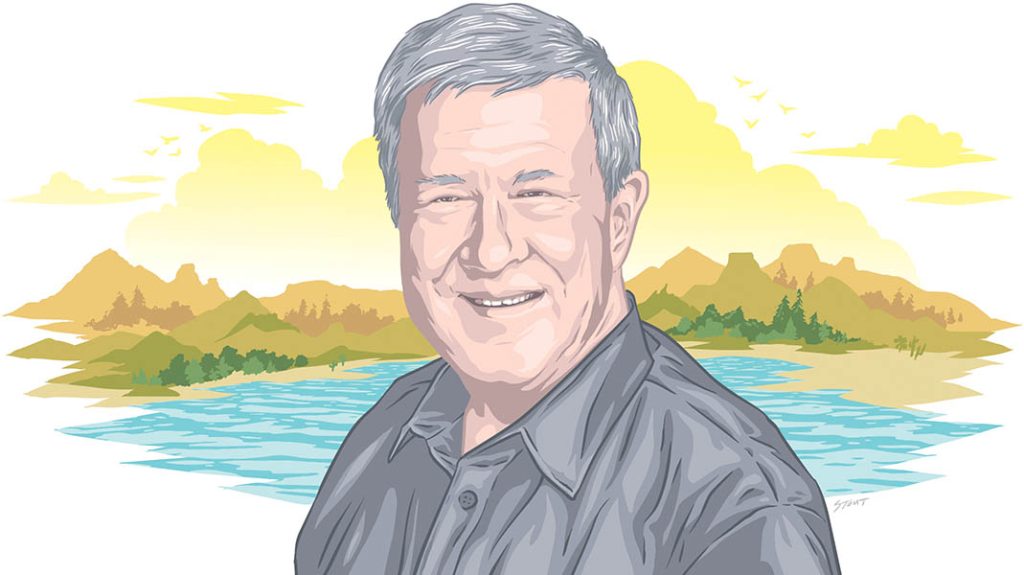
Illustration by Jason Stout
Andrew Sansom got his first job in 1959 as a lifeguard at Lake Jackson Municipal Pool in his hometown about 55 miles south of Houston. Little did the 14-year-old know the job would set the stage for a lifelong career in parks administration and environmental conservation. “I stayed with that summer job for eight or nine years, literally until after I was married,” recalls Sansom, who later became executive director of the Texas Parks and Wildlife Department. “I discovered that Texas Tech had a degree in parks and recreation. I couldn’t imagine that you could actually have a career in that, but that’s how I ended up at Tech.”
Sansom’s studies in Lubbock led him to Washington, D.C., where he worked for the U.S. Department of the Interior and Federal Energy Administration. Returning to Texas, he became director of The Nature Conservancy in Texas, and then director of land acquisition and executive director of Texas Parks and Wildlife during the 1990s. During his 13 years with the agency, Sansom was a central player in the state’s acquisition of Big Bend Ranch State Park, Devils River State Natural Area, and the forthcoming Chinati Mountains State Natural Area. He next went to work for Texas State University in San Marcos, where in 2012 he founded the Meadows Center for Water and the Environment. The institute, which is located at Spring Lake—the headwaters of the San Marcos River—promotes research and education for the protection of water resources.
Now semiretired, Sansom lives with his wife, Nona, in a restored 1857 limestone-block house in Stonewall. He teaches courses at Texas State while also writing and working on his ranch. He recently co-produced The Art of Texas State Parks, a Centennial Celebration, 1923-2023, a collection of original artwork and essays honoring the 100th anniversary of the Texas State Parks system.
TH: What sparked your interest in parks and the outdoors?
AS: We had a tradition in our family that every Sunday afternoon we’d go driving. Brazoria County was pretty rural at that time, so we would spend the day looking at the country. When I was in junior high, we lived on a creek that was a tributary of the Brazos. My dad and I built a wooden boat together, and every day when I came home from school, I’d get in that boat and fish or paddle. I went all the way to the Gulf a couple of times—16 or 17 miles by river.
TH: What have been pivotal moments in the history of Texas’ state parks?
AS: The first would be Gov. Pat Neff’s peculiar interest in the out of doors. It was his administration that created the State Parks Board. If you read Neff’s writings, he was pretty passionate about the out of doors. And apparently so was his mother, for whom Mother Neff State Park is named, because she donated the land to the state. The second thing that comes to mind is the Civilian Conservation Corps. Most of the state parks up until the New Deal era were donated. And there was very little infrastructure because the funding wasn’t there. The CCC presence in Texas was transformational. The next episode was the drought of the 1950s, which caused the state to build about 200 major reservoirs, many of which have state parks, like Inks Lake and Ray Roberts.
TH: How would you assess the vitality of Texas’ state parks today?
AS: The most significant thing financially that has happened to the state parks since John Connally was governor [in the 1960s] was the constitutional dedication of the sporting goods sales tax to state parks in 2020. As ecstatic as I am about the passage of the constitutional amendment, we’re still not acquiring and establishing enough parks. If you try to get into Enchanted Rock now, you might have to wait four months to get a reservation to camp. There are only 89 state parks, and the demands on them are unbelievable. There just aren’t enough.
TH: Why is it hard for the state to add parks?
AS: There’s probably more funding available now for acquisition than there has been since the ’80s. But it’s not enough. The economic growth in the state has caused those acquisitions to be extremely expensive. When we purchased Big Bend Ranch State Park in 1988, it cost $42 an acre. And we bought over 300,000 acres for like $8 million. Today, the most recent state park is called Palo Pinto Mountains, west of Fort Worth, and it’s going to cost more than $30 million before we’re done. Most acquisitions today—the last two are Palo Pinto Mountains and Powderhorn Ranch, which is on the coast—have been a combination of public and private money. They wouldn’t be done without philanthropy.
TH: Texas Parks and Wildlife works to encourage park visitation among city residents who haven’t been to parks. Why is that important?
AS: Texas is so dramatically urbanized that children, and particularly children of color, are not getting to these places. So, a challenge facing the parks system is to diversify its users. They’re making progress, but it’s still an issue—the population of the people that use state parks is not as diverse as the population of the state. And that’s important because we know that those experiences are beneficial for kids. But secondly, it’s people who use the out of doors that go to the Legislature and demand more funding for state parks or reforms in environmental laws. As the state population diversifies, we need to try to make sure that those changing demographics are supportive of conservation.
TH: What is something Texas has done right when it comes to conservation?
AS: Texas is 95% privately owned, and the biggest single terrestrial environmental problem we face is the continued fragmentation of family land. One of the most important things Parks and Wildlife has done over the years is to dramatically increase the protection of private lands, which enables families to stay on the land but to manage it in an environmentally appropriate way and protect it perpetually. We’ll never have enough money to protect the landscape—you can’t buy enough land to save the wildlife habitat, the aquifer recharge, the watersheds. You have to work with landowners.
TH: What is the biggest conservation challenge facing Texas?
AS: One of the biggest is water. Texas has the most well-preserved system of bays and estuaries of any state, but it is entirely dependent on fresh water flowing down the rivers to nourish them. And we hardly do anything to protect it. There are laws on the books that provide protection, but the regulatory agencies have never really put any teeth into that. We treated the water in our rivers and streams as if it was infinite up until about 1985. That’s when we began to look at the total availability in the rivers before we granted water rights. But by that time, most of it was already allocated. And yet we’re going to have twice as many people to provide water for in the next 50 years. In my mind, that’s very daunting.
Find The Art of Texas State Parks at booksellers and the Texas A&M University Press website.








